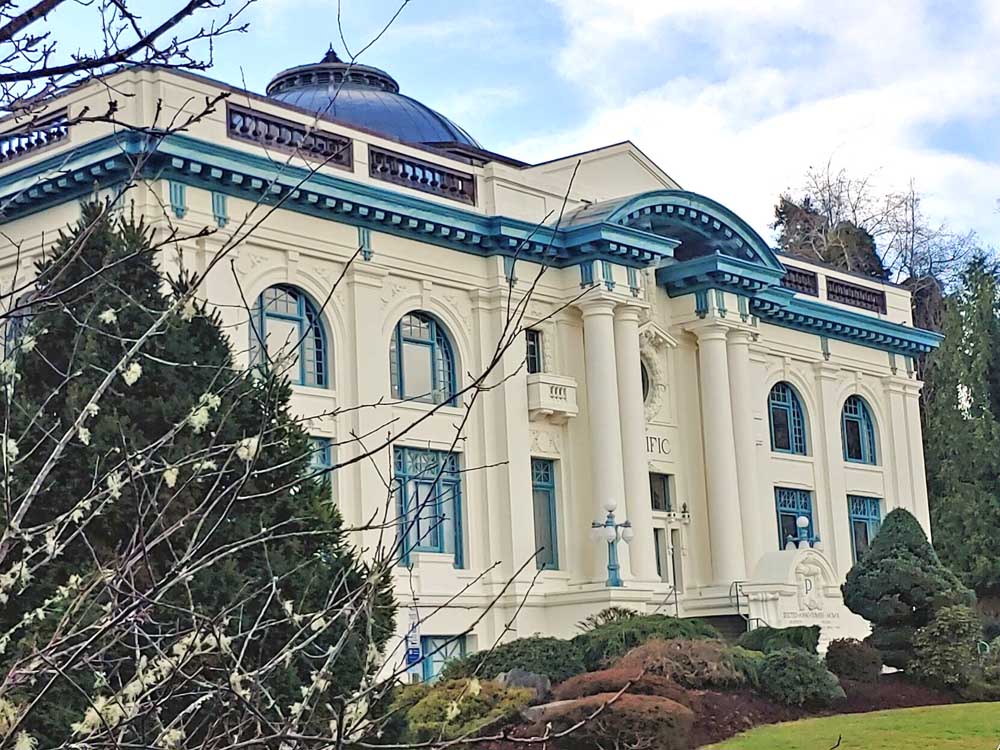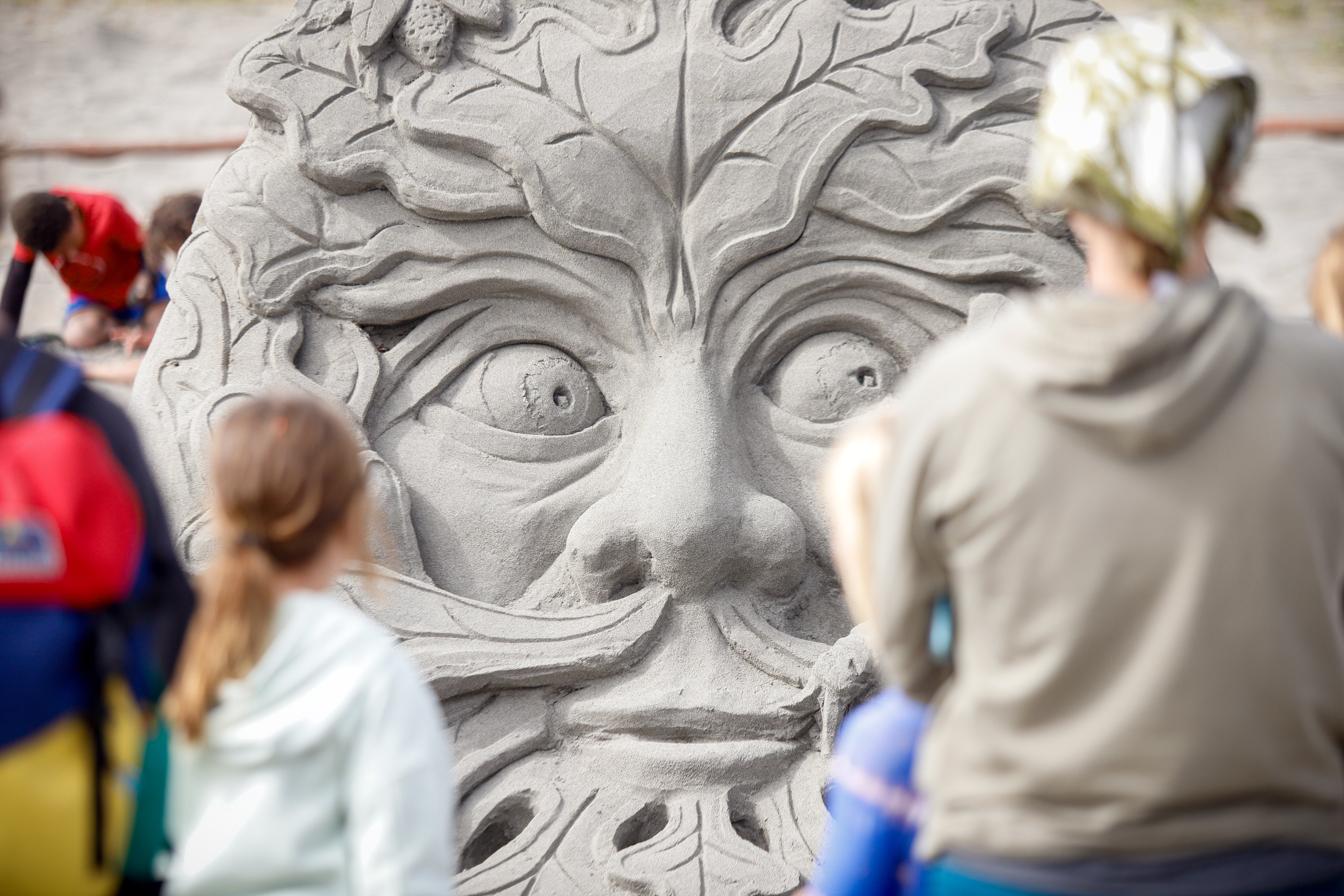Shoalwater Willapa: Nahcotta
Published 5:00 pm Tuesday, June 1, 2004

- John Morehead was a leading citizen in Nahcotta, and this was his house, grand by standards of the time. A park on his former property near the port still bears his name.
In 1888, capital was raised for the newly organized Ilwaco Railroad and Navigation Company, and with financial backing from Portland the first five miles of narrow-gauge railway track was laid, starting at the Ilwaco dock. Nearby, workers constructed an engine shed, machine shops, and a turntable. Additional capital was raised, with company stock offered to local subscribers.
Trending
During the first year of construction, rails went up Ilwaco’s main street, past Black Lake, and northward through Seaview to Long Beach. Stations were built at convenient stops, and at Seaview, a small shed-like waiting room and platform was erected near Jonathon Stout’s Sea View House.
Another station was placed at Henry Tinker’s hotel at Long Beach. After a pause, construction of the tracks reached Lewis Loomis’ new mansion, just south of Klipsan Beach. Work then continued north to Ocean Park, the route bending east to where a long railroad wharf, built on a piling, extended into a deep water channel of Shoalwater Bay.
Lee Osborn, who spent part of his youth in Nahcotta, remembered the old railroad. “The tracks were 36-inch gauge, as compared with four feet, eight and half inches standard gauge. The passenger cars had open platforms and dangerous old link and pin couplers. The three little locomotives were woodburners and spare engines were stored in Ilwaco, but the car shops were at Nahcotta, where most of the cars were kept.”
Trending
The U.S. Lifesaving Station at Klipsan Beach began using the rail line to haul its lifeboat and crew to various points along the ocean beach, wherever there was a need for rescue activities. Logging companies around Shoalwater Bay towed rafts of logs to Nahcotta, where they were loaded on flatcars and taken to Ilwaco. Timber was cut and finished at the Rogers Mill, or shipped to Astoria and Portland mills, and oysters and cranberries were also transported on the line. The steamer Tom Morris, and later the Reliable and Shamrock, carried passengers and mail around the bay, to and from Nahcotta, making connections for points along the Peninsula or to the Columbia River.
Baker BayIn 1805, when Lewis and Clark first saw the Columbia River estuary, they viewed a huge, thundering, and foaming bay. At Point Ellice, Clark wrote of a blustery point where the north end of the Astoria bridge approach is now located. More than 10 miles upriver, near Altoona, one could view the heavy echoes of swells that entered the mouth of the river. At the time of the first Euro-American contact of the 1790s, the sailors of a 65-foot brig could use Baker Bay as a port of call. Because of the effect of dikes, pilings, and fish traps, the bay began filling in as early as the 1880s, with the mean low water mark drastically raised, from a depth of 18 feet, to no more than today’s foot and a half clearance.
Significant changes in the historic deposits of Columbia River sand had taken place by the first half of the 20th century, stemming from the upriver construction of the large hydroelectric dams, most notably from the Bonneville site. Dredging by the U.S. Corps of Engineers tended to pile sediment along the sides of the river nearer the mouth, where shifted and re-directed channels have taken out littoral cells. At the present time, in 2004, it is predicted that if erosion patterns continue, the Cape Disappointment State Park campground could be gone in a decade.
In 1874, the Loomis brothers’ Ilwaco Navigation Company built a dock at Ilwaco. Sailing sloops were replaced by the steamers U.S. Grant and the Varuna, and two years later the company purchased the 93-foot steamer General Canby, built at A. M. Simpson’s South Bend lumber mill. For more than 15 years the Loomis company transported passengers from the Columbia River to Shoalwater Bay by horse-drawn coaches, along the Weather Beach (the ocean beach). By 1882, it was estimated that as many as 5,000 people visited the peninsula and Shoalwater Bay each summer. To meet the demand, a new warehouse was added at Ilwaco and a larger steamer, the General Miles, was added to the Columbia crossing.
During these prosperous years, B.A. Seaborg established his Aberdeen Packing Company. Seaborg, a Swedish-Finn, was followed by other Finnish countrymen who came to work in the sawmill or fish canneries. At this time, Seaborg and Lewis Loomis agreed to join together to construct the Ilwaco railroad north to Shoalwater Bay. Almost from the outset of the railroad plan, the silting problem at Baker Bay required that the steamers be held away from the Ilwaco dock until the tide was sufficiently high enough to allow safe moorage.
Nahcotta v. Sealand From a contentious beginning in the late 1880s and early 1890s, the adjacent villages of Nahcotta and Sealand vied to become the bay terminus for the Ilwaco Railroad and Navigation Company. The general area had been part of the (ca. 1850s) Donation Land Claim of John Crellin, Jr., and was named to honor Chief Nahcati.
Although it is assumed that Oysterville had been the first choice for the railroad’s bay terminus, it was clear to the company that the old Crellin claim was a superior location for a boat launching area. At Nahcotta/Sealand, the bay channel made its closest approach, where the deep water came within a quarter of a mile of the shore.
Nahcotta’s competition was provided by B. A. Seaborg’s newly platted Sealand, on land purchased from the claim of John Briscoe. Seaborg, a major stockholder of the railroad company, designed to have his new “town” own and control the line’s bay terminus, and for the following two years a duplication of shops and facilities was established, with Sealand on the north side of the tracks, and Nahcotta to the south. Together, the two rivals created two saloons, three general merchandise stores, two hotels, two meat markets, a creamery, a boatbuilding business, a blacksmith shop, and a school (located across the road on a small hill).
Lee Risley Osborn remembered C. M. “Pegleg” Stark, the town’s blacksmith. “Pegleg Stark was a crusty hard drinkin’ old codger with white whiskers and a wooden leg of the old fashioned variety. His wife was reputed to keep the dirtiest house in town. Her name was Maria, pronounced ‘Mar-eye-a.’ “
Regardless of the duplication of services, business boomed for a time, with merchandise, passengers, mail, oysters, salmon, logs, and freight shipped between the Columbia River and Shoalwater Bay. Daily, tri-weekly and weekly passenger and mail boats connected the peninsula with North Cove, Naselle, South Bend, and Willapa City. There was also a daily stage to Oysterville, with a fare of 25 cents. Although Nahcotta had been awarded a post office in October 1889, within six months Seaborg found a way to move the office across the railroad tracks to Sealand, just yards from its former location.
Lewis Loomis, B.A. Seaborg, and Jacob Kamm were major stockholders in the railroad company, but because of personality clashes, disagreements caused a rift between the men. When Seaborg built his Sealand Hotel, and then succeeded in getting the Nahcotta post office moved to his side of the tracks, Loomis purchased the Paul property and began to develop Nahcotta. Seaborg placed Sealand on the ballot to contest the 1892 county seat battle, which was keenly challenged by South Bend interests.
Loomis brought a lawsuit against the ambitious Seaborg, and when case was settled out of court, the canneryman sold his railroad stock to Jacob Kamm. The embattled Seaborg’s fortunes suffered additional reversals when South Bend won the county seat vote and Nahcotta took back the post office in February 1894.
Bayshore portDuring Nahcotta’s early years, a single dirt road connected several businesses, including small hotels operated by James Morrison (north side of the tracks), Albert and Louisa Hughes (south side), and several years later by H. H. Johnson, W. D. Taylor, and J. A. Petit, who also operated a saloon. A second saloon was owned by W. W. Ward. An early clam cannery was established by Arthur Wentworth and John W. Kleeb. A decade later other clam canneries were operated by the Cottle, Shagren, and Sigurdson families.
The Hughes’ Nahcotta Hotel, which had opened in 1890 (and presumably rebuilt after the fire), was sold and barged to South Bend in 1924. The new owner, Fred Katzer, situated the building across from South Bend’s Carnegie Library, where it sat until the 1950s. B.A. Seaborg leased his Sealand Hotel to Charles Shagren, who was appointed Nahcotta’s postmaster in 1898. The county’s first newspaper, the Pacific Journal, had moved from Oysterville to Nahcotta/Sealand in 1890, but two years later the plant was moved again, this time to Ilwaco.
With the completion of the railroad, J. A. Morehead built his new store in Nahcotta. Morehead later built a branch store at Ocean Park, eventually selling his holdings to Trondsen and Brown. Today, Jack’s Country Store stands at the same location.
By 1909, Nahcotta, which maintained a small population of 125, had been the terminus of the railroad for nearly 20 years. Residents and visitors of the village had remained dependent upon the railroad wharf to reach the docked steamers, something the company’s directors disliked. Passengers were required to pay freight charges on each package that went over the wharf, no matter how small, unless it could be hand carried to and from the boats. The result of this policy was that a significant amount of trade was diverted from Nahcotta, going instead by rail to Portland, and then to Ilwaco via the Columbia River.
Over the years various injuries were sustained by steamer passengers walking over the company wharf. When a damage suit was brought against the railroad in 1908, there was speculation that passengers would be prohibited from using the wharf. To counter the threat, former county commissioner J. A. Morehead petitioned the people of Nahcotta to support the appropriation of funds for a new and separate dock. After Morehead presented his case to the commissioners, county engineer Gibbs promptly surveyed the chosen location for the new public wharf, which was located about three blocks below the railroad wharf.
Lee Osborn returned to Nahcotta for several months in 1909, after having been gone for seven years. Osborn was surprised by several changes that had taken place during his absence.
“Nahcotta had another store, and a room had been added onto the schoolhouse, replacing the poles that had formerly held it up. The county had built a dock north of the railroad dock and the locomotives had been converted to oil burners.”
Osborn also noted that the steamer Tom Morris no longer operated on the South Bend run and that the sailboats had disappeared.
The bay presented a completed reversal, with lots of gas boats and not a sail in sight, and there were two new passenger boats, smaller but modern, and almost twins for looks. They were more than 75 feet long and had lots of power, and were named Shamrock and Reliable. The Shamrock was fastest and had the summer run, while the Reliable handled better in rough weather and was used in the winter. Both boats were in service during the summer tourist season.
The boats were owned and operated by Capt. Alfred Reed, of South Bend. Besides passengers, they handled freight and mail, and were a small gold mine over a period of 15 or more years. Capt. Reed was a good businessman and one of the best boatmen and navigators to ever hit the bay. He had one failing though, and it finally led to a sad ending for him. Cap would go on an occasional spree while off duty. His favorite drunken pastime was to enter a restaurant and walk the entire length of the counter with one arm extended, raking all the bottles, bowls, shakers, and so forth off onto the floor. He always went back after he sobered up and paid for the damages, but he made one big error. He tried it twice in the same place, and the Greek proprietor was ready for him, and bopped him over the head with a bottle. The injury caused Cap to lose his mind, and he was sent to the asylum at Steilacoom. I heard he died there in 1935.
In later years, John Morehead told of Nahcotta’s disastrous fire that took place on Jan. 29, 1915. John, who was a small child at the time, recalled that the conflagration had started when the Hughes Hotel caught fire from a overheated chimney, quickly spreading through the entire business area, including the post office, railroad depot and trestle, hotels, and shops. The town’s teenagers and shop workers ran to rescue valuables from Morehead’s Store, but very little could be saved. Firefighters from around the peninsula rushed to the scene, some on the railroad, but arrived too late. After the fire, Ocean Park took the lead as the area’s business district, but Nahcotta remained as a railroad terminus with its oyster and clam houses.
Changes for the RailroadSoon after the turn of the 20th century the I.R. & N. was purchased by the Washington-Oregon Railroad and Navigation Company, which in turn was owned by the Union Pacific Railroad Company. With the retirement of Kamm and Loomis, the new organization improved the tracks, cars, and support equipment. New tracks were extended to Megler, with a tunnel dug under Scarborough Hill, the site of Fort Columbia.
Thirteen miles of track were laid to Megler, where there was a deep water moorage.
Several new locomotives were put into service, heavier rails were laid, and new stations were built. Beginning in 1908, the railroad was finally operated on a regular time table. Stories still abound about “the railroad that ran by the tide,” but the operation ran on a regular schedule until it shut down in 1930.
Nahcotta’s Businesses and Points of InterestThe Port of Peninsula district was established in 1928 and serves several industries, including oystering, crabbing, salmon, recreational boaters, as well as providing facilities for lease tenants and the general public. At the present time there has been a series of improvements to the Nahcotta Mooring Basin. The port’s fueling facility, which was constructed in 1994, provides more than $140,000 in annual revenue. A gillnet float was constructed in 1996 and currently is used as a net float. Electrical improvements were made to other facilities owned by the port, including the docks occupied by the Wiegardt plant and the Ark Restaurant.
Several opening houses and canneries have operated in Nahcotta over the years, with most of them in the vicinity of the wharf. Brothers Fred, John, and Dobby, Sr. Wiegardt brought the old Solomon Clam Cannery across the bay from North Cove in 1918. In 1930, Joe Doupe and several partners formed the Ilwaco Oyster Company and constructed an opening house. The plant was later sold to Vern Hayes, who then sold it to Jack Wiegardt. Today, the expanded plant is known as the Jolly Roger. Ira Murakami and Erling Bendiksen operated separate canneries at the end of the wharf. The Murakamis sold their plant to Coast Oyster in the 1950s, and both it and the East Point facilities still exist, but are no longer used as opening houses.
Nanci Main and Jimella Lucas have owned and operated the Ark Restaurant since 1981. The women bought the restaurant from Frank and Candy Glenn, local cranberry growers, who had owned it for 17 years. Prize-winning cooking and baking has been featured in many national and regional publications, including Newsweek magazine and the New York Times. Lucas has pointed out the Ark’s dependence on the seafood of Willapa Bay, including oysters, clams, sturgeon, salmon, along with locally grown vegetables, fruits, and herbs.
Situated next to the bayshore, near the intersection of Bay Avenue and Sandridge Road, the Moby Dick Hotel has been a fixture since its origin in 1929. At one time there was a nine-hole golf course on the property. During World War II, the proprietors (Mr. and Mrs. Houser) leased the hotel and grounds to U.S. Coast Guard personnel, who brought horses to the Peninsula to be used for guard patrols on the ocean beach. Mrs. Houser lived in the hotel until the property was sold after World War II. Resisting opposition from local property owners, the declining property was sold to Fritzie and Edward Cohen in 1988. Since that time, Edward has passed away, but Fritzie continues to operate the property and to lobby against encroachments of the bay. The hotel, with its surrounding gardens, attracts an allegiant following.
Finally, a replica of an oyster station house was erected at the Nahcotta wharf, to serve as an interpretive center. The small house features a 20-foot mural of the bay, a chronology of the area’s oyster industry, with photographs. A 14-foot dinghy, built in 1920 by Dan Louderback is a center piece of various artifacts, including oyster tongs and baskets.
Writer’s Notes
1. Nahcotta’s early general merchandise stores were owned by Henry Johnson, H. A. Haseltine, and Morehead & Company. Morehead’s early partner was Lewis Loomis. The business had its beginning at Oysterville in 1885. Other shops included the Shagren Meat Market and a bowling alley which had an abbreviated existence.
2. Mrs. J. A. Morehead was born in Portland, Oregon in May, 1865, to John and Anna Brown. Brown was Norwegian born (Bergen, 1836) and had come to the United States in 1850, at the age of 14. He died in September 1890, at the age of 74. Mrs. Brown was born Anna Hendricksen. John and Anna brought their family to Shoalwater Bay from Vancouver, Washington. They first lived at Bruceport where they ran a small hotel (see Chapter 2). Captain Brown had also been the master of the first steamboat on the bay. The family moved to Oysterville in 1876, where daughter Elizabeth became the postmistress. In 1885 she married J. A. Morehead, the stage coach driver of the combined passenger and mail service that traveled along the Weather Beach. Mr. Morehead would later serve as a director and vice-president of the Pacific State Bank in South Bend. The children of the Moreheads were Mrs. Charles Peterson, Mrs. Torvald Trondsen, and John Morehead. Elizabeth died on her 80th birthday, on May 28, 1945.
3. B.A. Seaborg built a general merchandise store in downtown Ilwaco. The property later became the Doupe Hardware Store.
4. Above Morehead’s Nahcotta store was a Order of Maccabees lodge, which was a popular place for dances and an occasional traveling show.
5. Two of the Nahcotta school teachers were from South Bend: Nels Murdock and Arthur Skidmore.
6. The Shagren (Swedish) name was originally spelled “Sjogren.”
7. The county seat election results: South Bend, 980; Sealand, 378; and Oysterville, 104.
Sources
1. Newspaper microfilm archives, Washington State Library, Tumwater: South Bend Journal, Ilwaco Tribune, Willapa Harbor Pilot, The Weekly Astorian, Chinook Observer.
2. Washington State Oral/Aural History Program, 1976: Dobby Wiegardt, Sr.; Charles Nelson.
3. Nahcotta: Crossroads for Willapa Bay and Peninsula,” by Mike Johnston. Chinook Observer, Jan. 1, 1981.
4. “Dobby Wiegardt, Sr.: Nahcotta High School’s only graduate,” by Brenda Melton Burnham, Chinook Observer, June 7, 1987.
5. “Beginnings: Nahcotta and sister city started with Clamshell Line,” by Edith Olson, Chinook Observer, Jan. 7, 1992.
6. “A General History of the Shagren Family,” by Helen Shagren Furlong, The Sou’wester, Spring 1998. Information sent to this writer by Nancy Lloyd.
7. Correspondence, Nancy Lloyd and Helen Shagren Furlong.
8. Ramblings of Lee Risley Osborn, by Lee Risley Osborn, 1940.
9. Discussions (some very brief, others much longer): Hobe Kytr, Dick Sheldon, Bruce Weilepp, Dobby Wiegardt, Jimella Lucas, Fritzie Cohen.









